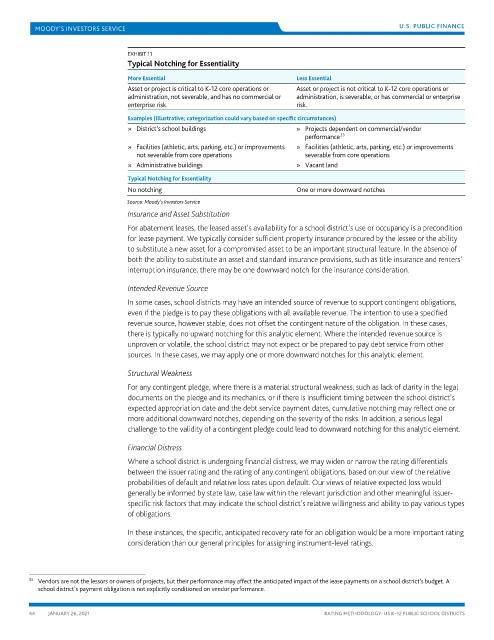Page 1684 - draft
P. 1684
U.S. PUBLIC FINANCE
EXHIBIT 11
Typical Notching for Essentiality
More Essential Less Essential
Asset or project is critical to K-12 core operations or Asset or project is not critical to K-12 core operations or
administration, not severable, and has no commercial or administration, is severable, or has commercial or enterprise
enterprise risk. risk.
Examples (Illustrative; categorization could vary based on specific circumstances)
» District’s school buildings » Projects dependent on commercial/vendor
33
performance
» Facilities (athletic, arts, parking, etc.) or improvements » Facilities (athletic, arts, parking, etc.) or improvements
not severable from core operations severable from core operations
» Administrative buildings » Vacant land
Typical Notching for Essentiality
No notching One or more downward notches
Source: Moody’s Investors Service
Insurance and Asset Substitution
For abatement leases, the leased asset’s availability for a school district’s use or occupancy is a precondition
for lease payment. We typically consider sufficient property insurance procured by the lessee or the ability
to substitute a new asset for a compromised asset to be an important structural feature. In the absence of
both the ability to substitute an asset and standard insurance provisions, such as title insurance and renters’
interruption insurance, there may be one downward notch for the insurance consideration.
Intended Revenue Source
In some cases, school districts may have an intended source of revenue to support contingent obligations,
even if the pledge is to pay these obligations with all available revenue. The intention to use a specified
revenue source, however stable, does not offset the contingent nature of the obligation. In these cases,
there is typically no upward notching for this analytic element. Where the intended revenue source is
unproven or volatile, the school district may not expect or be prepared to pay debt service from other
sources. In these cases, we may apply one or more downward notches for this analytic element.
Structural Weakness
For any contingent pledge, where there is a material structural weakness, such as lack of clarity in the legal
documents on the pledge and its mechanics, or if there is insufficient timing between the school district’s
expected appropriation date and the debt service payment dates, cumulative notching may reflect one or
more additional downward notches, depending on the severity of the risks. In addition, a serious legal
challenge to the validity of a contingent pledge could lead to downward notching for this analytic element.
Financial Distress
Where a school district is undergoing financial distress, we may widen or narrow the rating differentials
between the issuer rating and the rating of any contingent obligations, based on our view of the relative
probabilities of default and relative loss rates upon default. Our views of relative expected loss would
generally be informed by state law, case law within the relevant jurisdiction and other meaningful issuer-
specific risk factors that may indicate the school district’s relative willingness and ability to pay various types
of obligations.
In these instances, the specific, anticipated recovery rate for an obligation would be a more important rating
consideration than our general principles for assigning instrument-level ratings.
33 Vendors are not the lessors or owners of projects, but their performance may affect the anticipated impact of the lease payments on a school district’s budget. A
school district’s payment obligation is not explicitly conditioned on vendor performance.
44 JANUARY 26, 2021 RATING METHODOLOGY: US K–12 PUBLIC SCHOOL DISTRICTS

